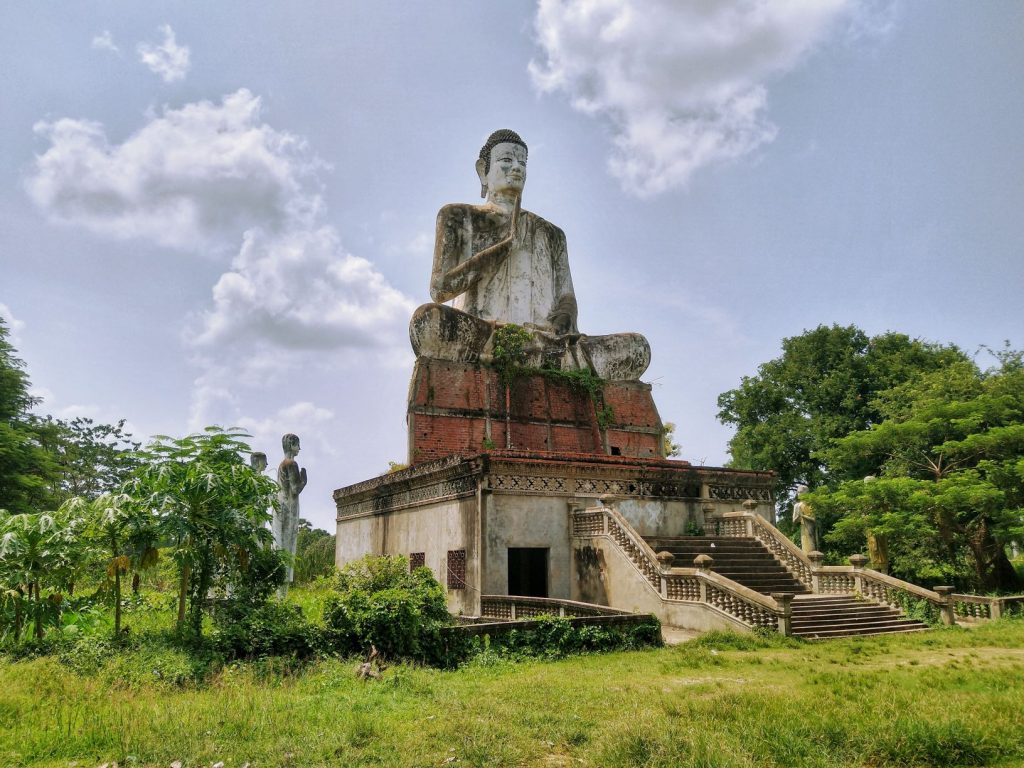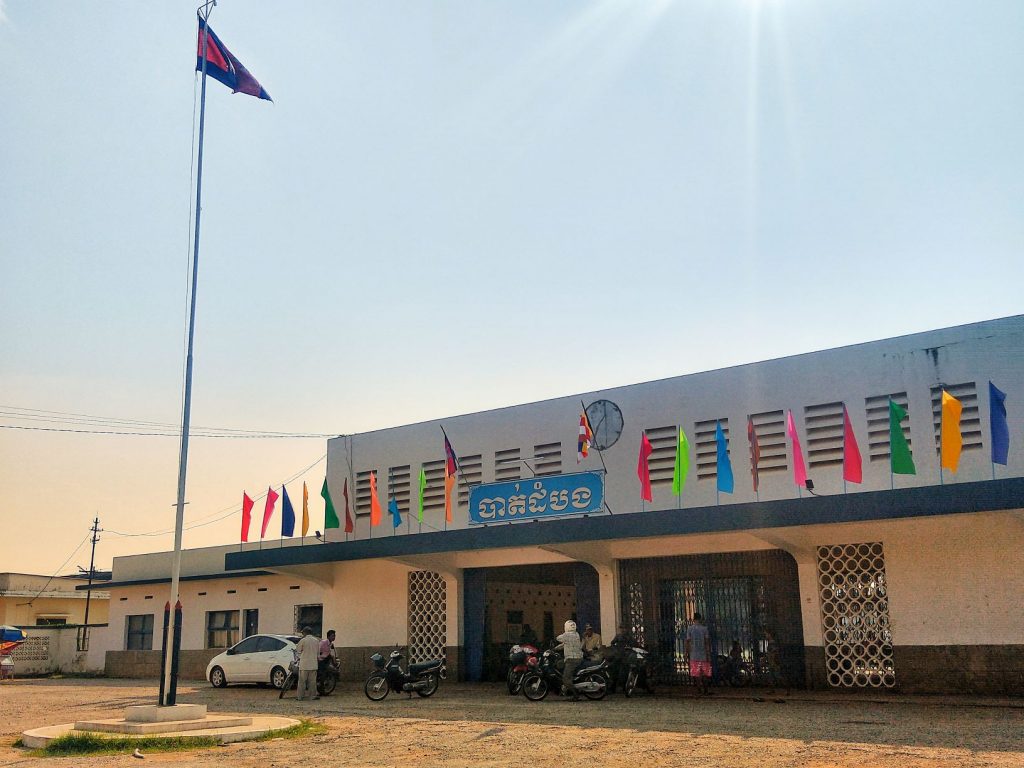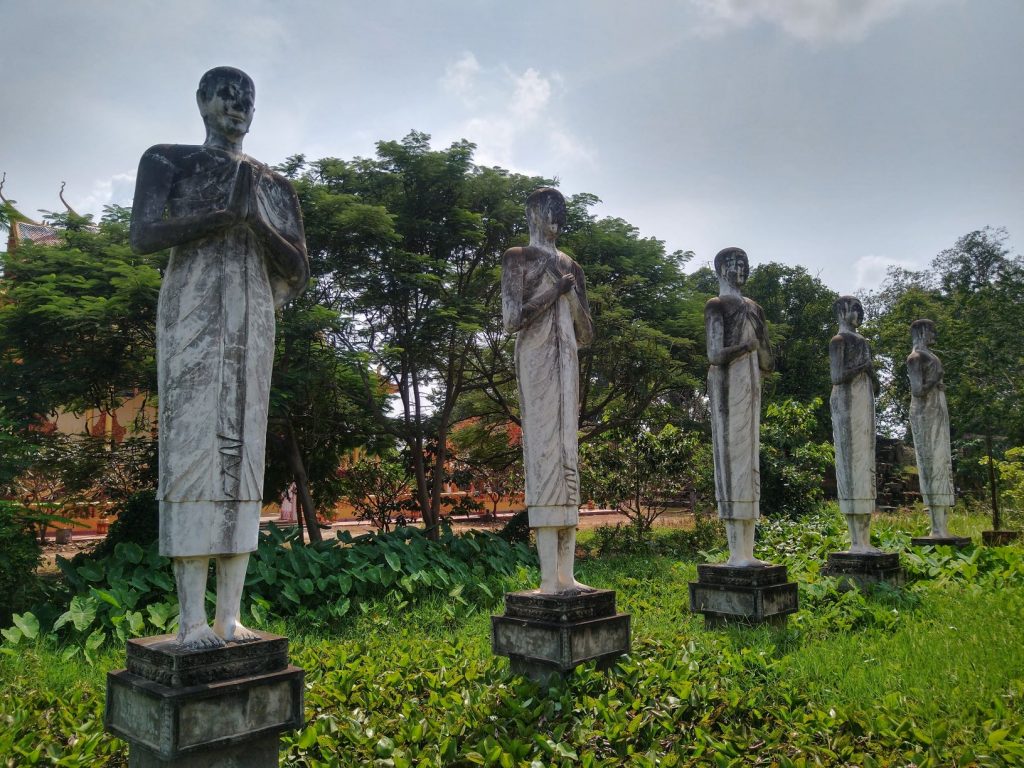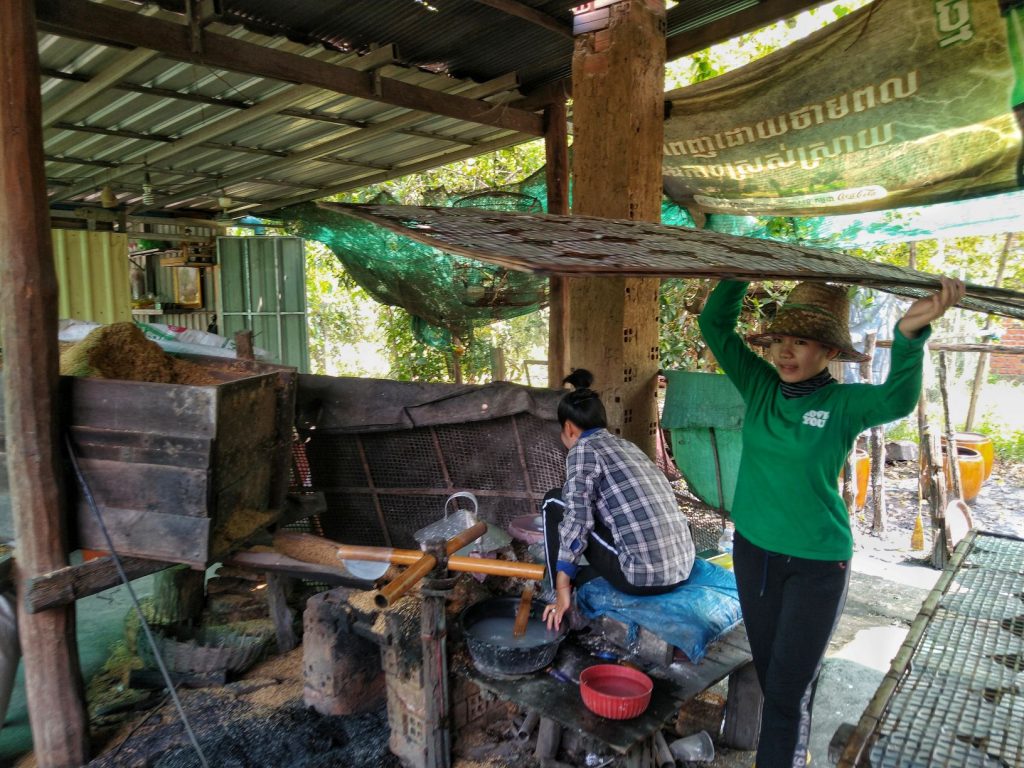The Ultimate Guide of Things to Do in Battambang
Battambang is the second largest city in Cambodia and as you’d expect there’s a lots of things to do. A place I heard we’d get a real feel for the country. It was certainly different to the tourist mecca of Siem Reap. The dazzling lights of night markets and pubs blasting out EDM are a stark contrast to Battambang’s dusty, litter strewn and faded streets.

Don’t let it put you off. Looks can be deceiving. Whilst Battambang itself isn’t full of must see sights, there’s a wealth of places in the surrounding area worth exploring. The most famous of which is the super touristic Battambang Bamboo Train. Yet travel further and there’s a wealth of culture and history to explore. Here I’ll tell you all about our Battambang experience.
Battambang itself is a very walkable city. We started off by visiting the Buddhist Temple Wat Piphitthearam.

I’d read in a guide book that monks were always there to show you around and practice their English. What we saw was a tiny version of a ghost town. There was no one in sight and Wat Piphitthearam looked like it had been abandoned. Much of the area was crumbling and had litter scattered across the orange brick floor. Whenever I’ve seen Buddhist monks walking around a temple, they usually sweep up as part of their daily chores. This surely couldn’t be an active temple.
We moved on and down to 2.5 Street. Apparently this is the best preserved street in Battambang, showcasing the best of the old French style shop houses. It was run down. There was nothing discernible about the street, sadly now a place filled with litter. (You may have realised by this point that Battambang has a huge litter problem).

Learning that Battambang had an old railway station, I was quite excited. My mind filled with visions of a grand building lost in time. The ticket counters apparently still in tact and the tracks out back overgrown with years of weeds. What I got was something very different. The building is simple and without any style. It’s pretty much just a concrete shell with rectangular windows were the ticket sellers sat.
That’s it!

I was starting to think the guide book needed to flesh out the word count, as so far Battambang’s ‘top sights’ were an absolute sight alright.
Venturing on, we explored the small Battambang Provincial Museum. It was actually a pleasant surprise. There’s some beautiful architecture concealed within. Artefacts excavated from the surrounding area and Angkor Wat itself. You can get up close to immaculate stone carvings and learn with the accompanying English descriptions.

For Battambang city itself that about sums up the sights. You can also stroll along the river, which we did on the way back to our hostel.
I wanted to see a ‘real’ Cambodian city and with Battambang that’s what I got. Not everywhere is full of places to actively engage western tourists and that’s what gives Battambang’s its charm. It’s a place that is what it is. A faded glory and now a regular city where people live and work.
Exploring the Things to Do Around Battambang
The Battambang Bamboo Train
The next day we explored far and wide around Battambang. Hiring a tuk tuk driver, off we sped. The first stop being the infamous Battambang Bamboo Train. When the Khmer Rouge took control of Cambodia in 1975 they dismantled a lot of the country’s rail network. (Yet another colossal blunder perpetrated by Pol Pot and his cronies).
Few stretches still remain, but 7km outside of Battambang lies one such piece of track. For $5 USD a person, members of a local co-operative will hastily assemble a bamboo platform on to wheels, strap on an engine and speed you down the track. It’s a health and safety nightmare, but exhilarating all the same. With just a cushion to sit and nothing to hold on to, you’ll race along on the Bamboo Train at speeds of around 30km/h.
This is a single line of track, so when bamboo trains travelling in opposite directions meet, there’s a problem. Someone has to give way. The general rule is that the bamboo train with the most passengers has to get off the track. The train is quickly pulled apart and lifted off the track. The bamboo platform on one side and the wheels like gym weights lifted off to the other.
GAME ON! It’s time to proceed.
At the end of the line the bamboo train driver will stop at a tourist market. There’s no end of locally made crafts and ‘I Rode the Bamboo Train’ T-shirts.
Wat Samroung Knong
Next up was Wat Samroung Knong. A Buddhist Pagoda which houses 10,008 skulls. All sadly victims of the Khmer Rouge regime. In keeping with Buddhist burial traditions, the skulls excavated from nearby killing fields are given the dignity of a peaceful and respectful resting place. Around the base of the temple, carved scenes depict the horrific torture people endured. Throats are cut, tongues pulled out and bodies dumped in burning vats. There’s even depictions of cannibalism, which a Khmer Rouge General instigated in Battambang.

Adjacent to Wat Samroung Knong are two eye opening experiences. The first is a Torture Museum. Whilst nothing more than a small shed, it shows paintings done by a Khmer Rouge prisoner, depicting the horrific scenes they experienced. Sitting in the back of the Wat courtyard lies the Battambang Women’s Prison.

Now bordered up and in a state of decay, it still has an eerie feel to it. There was a strange smell lingering in the air. A smell which our tuk tuk driver said was death!
Time to move on.
Trying Bamboo Sticky Rice
We stopped for some traditional bamboo sticky rice. At the side of the road, locals dry out bamboo. Inside they stuff mounds of sticky rice and black beans, compacting it down in to a stodgy block. It’s then heated over an open fire and sold as a tasty snack. Something which can keep manual workers going all day. To get to the goods inside, the technique is to roll the bamboo shoot between your palms as if trying to make fire. This loosens up the sticky rice. The shoot is then peeled back like a banana skin and you can break off bite sized chunks of the sticky goodness.
Once eaten the bamboo shoot is broken up and burned as fuel.

Ek Phnom Temple
Ek Phnom Temple are 11th Century ruins. Think of the Angkor Wat temples, but on a very tiny scale. Throughout South East Asia I’m constantly blown away by elaborate buildings and statues, seemingly in the middle of nowhere. The temple in front of Ek Phnom is one such place.

A gigantic stone Buddha sits astride an old concrete block, surrounded by equally impressive carved monks, rising out from the surrounding swamp. Venture inside the decrepit walls and you’ll see an even greater number of relics.

Sampling Local Battambang Food
By the time lunch rolled around, our tuk tuk driver asked us what we’d like to do. One suggestion was to go for spring rolls in a small village. With everyone on board, we set off to watch locals cook with precision and a labour intensive process.
Rice is ground up into a powder and then mixed with water. This is then heated and laid out on a rack to to dry. Each sheet a mini work of art.

We could choose our fillings, so naturally went for vegetables (being vegetarian after all). The second option was to have them fresh or fried. If fresh, the dry rice sheets are mixed with a splash of water to soften them up. If fried, they are placed in a pan of oil over a gas canister. I’m sure it’s a health and safety nightmare, but this is rural Cambodia, not the local restaurant back home.
They tasted divine. At only 1,000 Riel each ($0.25 USD cents) it was the probably one of the best value snacks we’d ever had.
Visiting a Local Battambang Family
Not on the itinerary, but something incredibly special, our tuk tuk driver asked if we’d like to visit his family. We were now in the area and he thought they might like to say hello.
It was an absolute joy. One of the things I enjoy most about travelling is meeting people and experiencing a different way of life. This was it in micro form. We all sat down and met his wife, recently born son, mother and neighbours. There was no hard sell, it was just a genuine meet and greet. Soon we were asked if we’d like to try some local fried grasshoppers from the fields. We politely declined.

Their home was a log cabin on stilts which is to protect it from rains in the monsoon season. Swinging underneath was his newborn son in a hammock. This was also where members of the family slept. Everything was so simple, but a beautiful atmosphere with a close knit family.
Khum Phnom Sampov – Battambang’s Killing Caves and Bat Cave
Our final port of call and an absolute must on any visit to Battambang is the area of Khum Phnom Sampov.
Paying a tiny national park fee of $2, we took a steep 20 minute walk up the hill. What we experienced was both shocking and heartbreaking.
The Killing Caves of Battambang
At the top of the hill a child dressed in her pink pyjamas ran up to us shouting “Killing Cave, Killing Cave, this way!”. Glancing at Maps.Me I could see we were heading in the right direction, so gave a polite “no thank you”.
The Killing Cave of Battambang is another chapter in Cambodia’s dark Khmer Rouge history. At the top of a mountain is a huge cave. This is a sight where people were killed and thrown in to the dark pit below. Bone fragments still remain and there’s an eerie silence in the damp air.

Descending the steps and waving to a pile of skulls in a glass stupa, the child casually pointed out “this is where they killed babies”. It was almost a throw away comment. She could just have easily been telling us directions to the bus stop.
I was dumbfounded by the situation we were in.
“How old are you?” we asked. “10” she replied. A 10 year old ‘tour guide’ had jumped on board uninvited to give us a history lesson. Asking what she would like to be, the child informed us that she didn’t know. She then asked “Can I come with you and you give me a job?”.
Here we were in what felt like the pits of hell, with a child wishing to leave their life behind and build something new.
“We sadly can’t give you a job” was the response, “but it’s important to stay in school and learn”. That didn’t seem to register, so the girl just asked for money. I’ve read no end of information that you shouldn’t give money to children, nor take them up on offers of being a tour guide. It encourages them not to go to school. Donating to a broader charity is a more sensible option.

This child had followed us around for 15 minutes without request and we anticipated that a begging style situation would happen.
It’s difficult, but we stuck to our guns. As we said sorry and walked away, she followed saying “give me money”. Eventually sitting on the steps and sulking as we departed.
Alongside the dark history of the Killing Cave, this was a sad situation to experience.
The Flower, Wind and Nature Caves
Venturing further up the mountain, there are other caves to explore. These are the Flower, Wind and Nature Caves. None are Killing Caves, rather religious Buddhist sites. All are spectacular. Huge statues adorn the courtyards. Sunlight cracks through the ceiling and shines on Buddhist effigies below. It’s also deadly silent. Offering a serene and peaceful calm from the world.

Phnom Sampov
Having reached the top of Phnom Sampov, it was time to take in the view. A gorgeous flat landscape of lush green fields below. We could see Battambang city far in the distance and occasional plumes of smoke rising from farmer’s fields. Moments like this are such joy.


There was just one thing to be mindful of. There’s a lot of monkeys here and you shouldn’t stare the alpha male in the eye. Otherwise they’ll become extremely aggressive. When the alpha male appeared, we naturally looked away, but he already had his eye on us.
Rushing forwards, the alpha male swiped Rose’s Coke can from her hand, dashed over to the steps and sat chugging away.
It was time to leave.

With sunset approaching, it meant only one thing. Time to visit the Bat Cave.
Battambang Bat Cave
Jutting out of Phnom Sampov is a cave home to over 1,000,000 bats. Yes; one million bats. Everyday at sunset these Wrinkle-Lipped Bats leave in search of breakfast. The sight is jaw dropping. Even though they fly out of the cave at an alarming rate, it still takes more than an hour for them all to leave.
It’s not just the sight of 1,000,000 bats overhead that is mind blowing. Throughout the nights these Wrinkle-Lipped Bats will eat 50-100% of their body weight. Insect pests such as Plant-Hoppers are their tastiest meal. By munching on these insects the bats are saving over 2,000 tonnes of rice crops which would otherwise be destroyed by pests. This equates to enough food for 21,000 Cambodians annually. Nature is indeed metal!
With the sun setting, that’s where our day exploring Battambang ended. The tuk tuk driver took us back to our hostel and we said our goodbyes.
Battambang left me with a wonderful feeling for rural Cambodia. It might not be the prettiest of cities, but the surrounding area is a place I’d urge you to visit on your Cambodia adventure.
How to get to Battambang
Battambang is Cambodia’s second largest city. Therefore it’s easy to access from almost anywhere in the country.
Towns and cities in Cambodia don’t have central bus stations. Therefore you will need to check a map for bus companies to buy tickets. Alternatively,the most sensible option is to book a bus through your accommodation. They will arrange the ticket and you’ll be picked up by the bus company in a minivan (or tuk tuk) and taken to the bus station. What’s even better is your accommodation usually doesn’t even add a commission. Even if they do it will be less than $1. Totally worth it!
How to book a tour of Battambang
Tuk tuk drivers all over Battambang will approach you for tours. The cost of their service will be $15-20 for the entire day, with entrance fees on top (allow around $8 for this). You can tell them where you want to go, or ask them to recommend places.
We booked a trip via our hostel; The Place. As you can probably guess from the above post, the trip was exceptional. The price was just $7 per person for a full day tour from 8:30AM – 6:30PM. The cost of the Battambang Bamboo Train and cave and temple fees were on top (a combined total of an additional $8).
The Place has excellent dorms, private rooms, an awesome chill out area and roof top bar. Plus you even get a free beer or soft drink when you arrive. I can’t imagine there’s a better place to stay in Battambang, but check out these links if you want to find the best deals.
Get the best value accommodation in Battambang here:
SHARE OR PIN THIS POST
